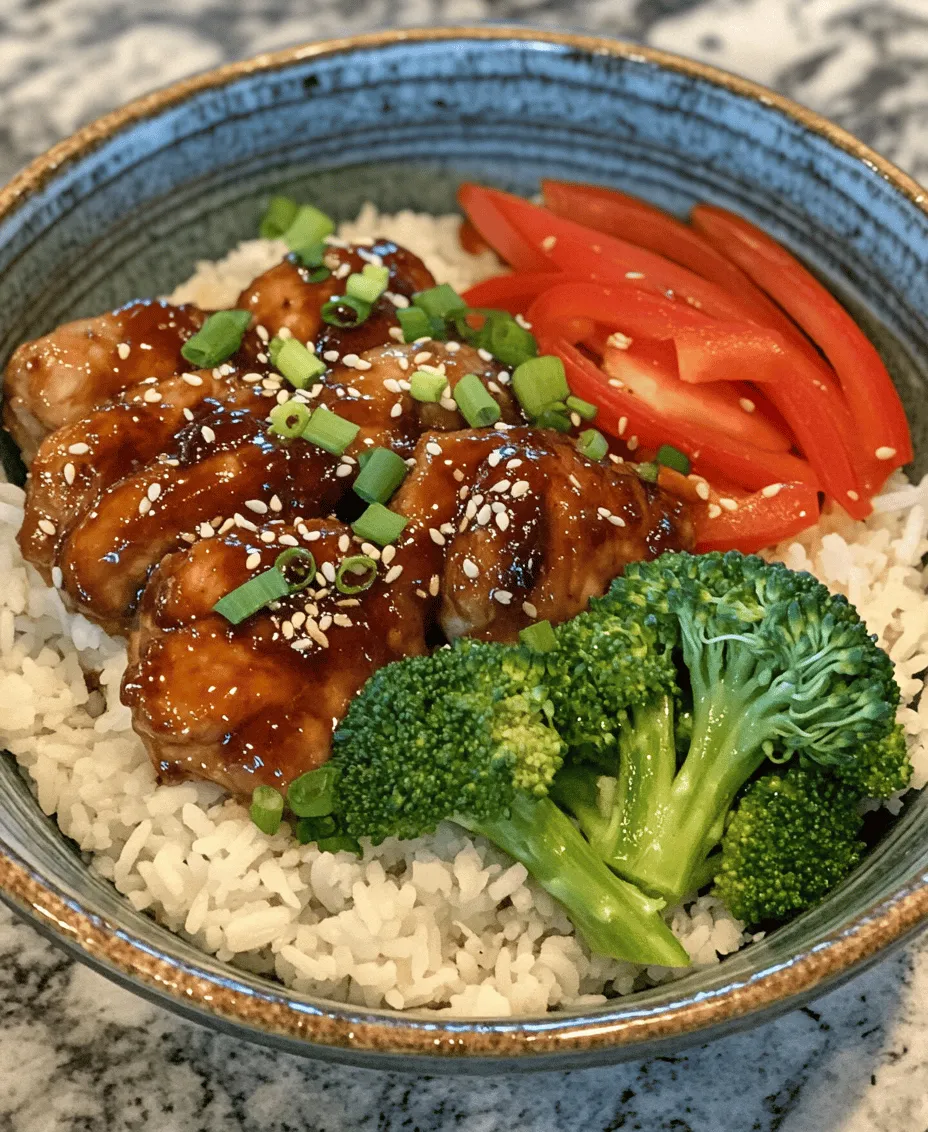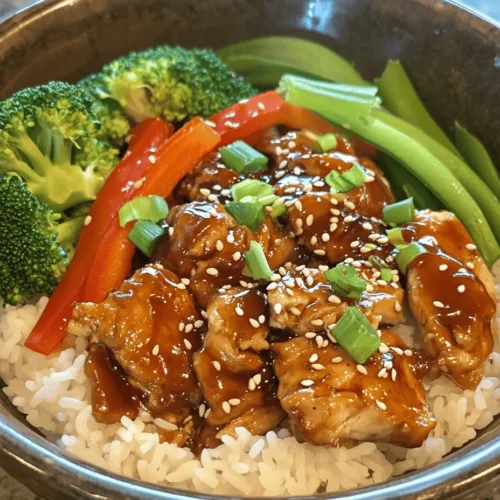Introduction
The Teriyaki Chicken Rice Bowl is a delightful staple in Japanese cuisine that has gained worldwide popularity for its harmonious blend of flavors and textures. This dish features succulent chicken glazed in a sweet and savory teriyaki sauce, served atop a bed of fluffy jasmine rice and complemented by vibrant vegetables. With its colorful presentation and satisfying taste, the Teriyaki Chicken Rice Bowl is not only a feast for the eyes but also a nourishing meal that can easily be prepared at home.
In today’s fast-paced world, home cooking is becoming increasingly valued, and the Teriyaki Chicken Rice Bowl shines as an ideal choice. Its balanced composition of protein, carbohydrates, and vegetables makes it a nutritious option for families looking to enjoy a wholesome meal without spending hours in the kitchen. One of the most significant advantages of making this dish at home is the ability to customize it according to personal preferences. Whether you prefer a sweeter teriyaki sauce or additional vegetables for added crunch, preparing this dish gives you the freedom to experiment while ensuring freshness in every bite.
This article will explore the essential components of the Teriyaki Chicken Rice Bowl, including an in-depth look at the key ingredients and a detailed step-by-step guide to preparing this delicious meal. By the end of this article, you will not only be equipped with the knowledge to create this dish but also appreciate its rich culinary background and the joy it brings to your dining table.
Understanding the Ingredients
Key Ingredients Overview
To create the perfect Teriyaki Chicken Rice Bowl, it is essential to understand the roles of each ingredient. The core components include jasmine rice, boneless skinless chicken thighs, teriyaki sauce, and an assortment of vegetables, such as broccoli and red bell peppers. Each element contributes to the overall flavor, texture, and nutritional profile of the dish.
Jasmine Rice
Jasmine rice is the preferred choice for this rice bowl due to its fragrant aroma and slightly sticky texture, which helps to hold the dish together. Unlike other varieties of rice, jasmine rice has a unique floral scent and a nutty flavor that pairs beautifully with the teriyaki chicken. This long-grain rice is also known for its fluffy consistency when cooked properly, making it an excellent base for the delectable toppings of this dish.
When preparing jasmine rice, it is crucial to rinse it under cold water before cooking. This step removes excess starch, preventing the rice from becoming gummy and ensuring a light, airy texture. The cooking method typically involves a simple ratio of water to rice, allowing the grains to absorb just the right amount of moisture for perfect doneness.
Boneless Skinless Chicken Thighs
Boneless, skinless chicken thighs are the ideal protein for this Teriyaki Chicken Rice Bowl. Compared to chicken breasts, thighs offer a richer flavor and remain tender and juicy during cooking. The higher fat content in chicken thighs allows them to absorb the teriyaki sauce more effectively, resulting in a more flavorful dish. Additionally, they cook quickly, making them a convenient option for home cooks looking to whip up a meal in a short amount of time.
Teriyaki Sauce Components
The teriyaki sauce is the star of the show in this dish, delivering a sweet and savory glaze that elevates the chicken and rice. Traditional teriyaki sauce consists of several key ingredients:
– Soy Sauce: This salty component serves as the foundation of the sauce, providing umami richness.
– Mirin: A sweet rice wine used in Japanese cooking, mirin adds a natural sweetness and depth of flavor.
– Brown Sugar: Enhancing the sweetness of the sauce, brown sugar also contributes to the glossy finish that coats the chicken.
– Sesame Oil: A few drops of sesame oil impart a nutty aroma and flavor, rounding out the sauce.
– Garlic and Ginger: These aromatic ingredients add complexity and warmth, making the sauce well-rounded and flavorful.
While traditional teriyaki sauce is delicious, many home cooks enjoy experimenting with modern adaptations, such as adding chili paste for a spicy kick or incorporating pineapple juice for an extra layer of sweetness.
Nutritional Benefits of Vegetables
In addition to the chicken and rice, vibrant vegetables play a crucial role in the Teriyaki Chicken Rice Bowl. Broccoli and red bell peppers are popular choices, not only for their visual appeal but also for their nutritional benefits.
– Broccoli: Packed with vitamins C, K, and fiber, broccoli contributes to overall health and wellness. Its crunchy texture contrasts nicely with the tender chicken and rice, adding variety to each bite.
– Red Bell Pepper: This colorful vegetable is rich in antioxidants and vitamin A, promoting good vision and skin health. The natural sweetness of red bell peppers complements the savory teriyaki sauce, making them a perfect addition to the dish.
By incorporating these vegetables into your rice bowl, you not only enhance its flavor and texture but also boost its nutritional value, creating a well-rounded meal that supports a healthy lifestyle.
Step-by-Step Preparation
Preparing the Rice
The first step in creating your Teriyaki Chicken Rice Bowl is preparing the jasmine rice. Start by measuring out the desired amount of rice, typically one cup, which serves about two people. Place the rice in a fine-mesh strainer and rinse it under cold running water. Gently swish the rice around with your hands to ensure all grains are thoroughly rinsed. You will notice the water turning milky; this is the excess starch being washed away, which is crucial for achieving the perfect texture.
Once rinsed, transfer the rice to a pot and add water. The general rule for cooking jasmine rice is a 1:1.5 ratio of rice to water. For one cup of jasmine rice, you will need one and a half cups of water. Bring the water to a boil, then reduce the heat to low, cover the pot, and let it simmer for about 15 minutes. After the cooking time is complete, remove the pot from heat and let it sit, covered, for an additional five minutes. This resting period allows the rice to steam and finish cooking, resulting in perfectly fluffy grains.
Once the rice is ready, fluff it gently with a fork and keep it warm while you prepare the chicken and vegetables.
Making the Teriyaki Sauce
Next, it’s time to create the teriyaki sauce. If you’re looking to make a homemade version, start by combining the following ingredients in a small saucepan:
– ½ cup soy sauce
– ¼ cup mirin
– ¼ cup brown sugar
– 1 tablespoon sesame oil
– 1-2 cloves of minced garlic
– 1 tablespoon freshly grated ginger
Whisk the ingredients together over medium heat until the sugar dissolves. Allow the sauce to simmer for a few minutes until it thickens slightly. If you prefer a thicker sauce, you can mix one tablespoon of cornstarch with two tablespoons of cold water, then add it to the sauce while it simmers. This will create a glossy glaze that clings beautifully to the chicken.
For those pressed for time, store-bought teriyaki sauce can also be used, but be sure to choose a high-quality brand for the best flavor. Regardless of your choice, the teriyaki sauce is what brings the dish to life, providing that quintessential sweet and savory taste that defines this beloved rice bowl.
Cooking the Chicken
With the rice and sauce prepared, it’s time to cook the chicken. Start by cutting the boneless skinless chicken thighs into bite-sized pieces for even cooking. Heat a tablespoon of oil in a large skillet or wok over medium-high heat. Once the oil is hot, add the chicken pieces in a single layer, ensuring they are not overcrowded in the pan. This will help achieve a nice browning on the chicken.
Cook the chicken for about 5-7 minutes, turning occasionally until it is golden brown and cooked through. The internal temperature should reach 165°F (75°C). Once the chicken is cooked, reduce the heat to low and pour in the prepared teriyaki sauce. Stir to coat the chicken evenly, allowing it to simmer for an additional 2-3 minutes, so the flavors meld and the sauce thickens slightly.
This cooking technique not only ensures a well-cooked chicken but also infuses it with the rich flavors of the teriyaki sauce, creating a deliciously satisfying protein for your rice bowl.
Adding Vegetables
To complete your Teriyaki Chicken Rice Bowl, it’s essential to include the vegetables that will add color, texture, and nutritional value. For this recipe, prepare broccoli and red bell peppers by cutting them into bite-sized pieces. You can choose to steam or sauté the vegetables.
If you opt to sauté, heat a small amount of oil in the same skillet used for the chicken, ensuring the flavors remain consistent. Add the broccoli and red bell peppers, cooking for about 3-4 minutes until they are tender yet still crisp. The goal is to maintain their vibrant colors and nutritional benefits while integrating them into the overall dish.
Once the vegetables are cooked, it’s time to assemble your Teriyaki Chicken Rice Bowl. Start with a generous scoop of jasmine rice at the bottom of the bowl, layer on the teriyaki chicken, and top with the sautéed vegetables.
In the next part of this article, we will discuss additional garnishes, serving suggestions, and tips for achieving the best results with your Teriyaki Chicken Rice Bowl. Stay tuned to explore the finishing touches that will elevate your homemade dish to restaurant-quality perfection.

Combining Sauce and Slurry
To achieve the perfect glaze for your Teriyaki Chicken Rice Bowl, the combination of sauce and cornstarch slurry is key. The cornstarch slurry acts as a thickening agent, giving the teriyaki sauce that glossy, restaurant-quality finish.
What is a Cornstarch Slurry?
A cornstarch slurry is a simple mixture of cornstarch and a cold liquid, typically water. This mixture is crucial for thickening sauces without altering their flavor, allowing you to maintain the integrity of the teriyaki sauce while achieving the desired consistency.
How to Prepare the Slurry:
1. In a small bowl, combine 1 tablespoon of cornstarch with 2 tablespoons of cold water.
2. Whisk the mixture until fully dissolved and smooth.
3. Once your chicken is cooked and the teriyaki sauce has simmered, gradually stir the slurry into the sauce. Keep stirring until the sauce thickens, which should take about 1-2 minutes.
This step not only enhances the texture but also ensures better adherence of the sauce to the chicken and rice, creating a more enjoyable eating experience.
Assembling the Bowl
Now that your chicken is cooked and the sauce is perfectly thickened, it’s time to assemble your Teriyaki Chicken Rice Bowl. Presentation plays a significant role in making meals appealing, and there are creative ways to layer your ingredients for a visually stunning dish.
1. Start with the Rice: Use a scoop of warm, fluffy rice as the base of your bowl. Jasmine rice is a popular choice, but you can also use brown rice or cauliflower rice for a healthier option.
2. Add the Chicken: Slice the teriyaki chicken into bite-sized pieces or leave it whole for a more rustic feel. Place it centrally on the rice, allowing it to shine as the star of the dish.
3. Layer on the Vegetables: Add a variety of colorful vegetables around the chicken. Consider using steamed broccoli, shredded carrots, snap peas, or sliced bell peppers. This not only adds a burst of color but also a range of textures and nutrients.
4. Drizzle with Sauce: Generously drizzle the thickened teriyaki sauce over the chicken and vegetables. This will enhance the flavors and keep everything moist.
5. Garnish: Finish off your bowl with garnishes such as sesame seeds, chopped green onions, or a sprinkle of nori flakes. These not only add visual appeal but also enhance the flavor profile.
6. Serve Warm: For the best experience, serve your Teriyaki Chicken Rice Bowl warm, allowing the flavors to meld together beautifully.
Nutritional Analysis
Understanding the nutritional profile of your Teriyaki Chicken Rice Bowl can enhance your meal choices and promote healthier eating habits.
Calories and Macronutrients:
A typical serving of Teriyaki Chicken Rice Bowl (including rice, chicken, and assorted vegetables) contains approximately 450-600 calories, depending on the portion sizes and specific ingredients used. Here’s a rough breakdown of the macronutrients:
– Protein: 25-35g (from chicken)
– Carbohydrates: 50-70g (from rice and vegetables)
– Fat: 10-15g (from sauce and chicken skin, if used)
Micronutrients:
This bowl is also rich in essential vitamins and minerals, thanks to the vegetables and lean proteins. You can expect to find:
– Vitamin A (from carrots and bell peppers)
– Vitamin C (from broccoli and snap peas)
– Iron (from chicken and rice)
– Fiber (from brown rice and vegetables)
Health Benefits:
Choosing lean protein sources like chicken not only supports muscle health but also provides essential amino acids necessary for various bodily functions. Incorporating a variety of vegetables guarantees a wider array of vitamins and antioxidants, which are crucial for maintaining optimal health.
Homemade vs. Store-bought Teriyaki Bowls:
When comparing homemade to store-bought teriyaki bowls, the homemade version typically boasts better nutrition. Store-bought options often contain higher levels of sodium, preservatives, and added sugars. By making your own, you control the ingredients and can customize the bowl to fit your dietary needs.
Variations and Customizations
One of the greatest aspects of the Teriyaki Chicken Rice Bowl is its versatility. You can easily customize it to suit different dietary preferences and tastes.
1. Protein Substitutions:
– Tofu: For a vegetarian or vegan option, replace chicken with firm tofu. Press and cube the tofu, then pan-fry it until golden before adding it to the bowl.
– Shrimp: For a seafood twist, sauté shrimp in teriyaki sauce until cooked through. This adds a delicious briny flavor to the dish.
– Beef: Thinly sliced flank steak or sirloin can also be marinated in teriyaki sauce and grilled for a robust flavor.
2. Vegetable Alternatives:
Experiment with seasonal vegetables to keep your dish interesting. Some great alternatives include:
– Zucchini
– Asparagus
– Baby corn
– Mushrooms
3. Gluten-Free Adaptations:
If you’re following a gluten-free diet, use tamari or coconut aminos in place of regular soy sauce. Additionally, consider using honey or maple syrup instead of traditional sweeteners like brown sugar to keep the dish gluten-free.
Serving Suggestions
To elevate your Teriyaki Chicken Rice Bowl experience, consider serving it with complementary sides and creative presentation ideas.
1. Accompaniments:
– Pickled Vegetables: Lightly pickled cucumbers or carrots can add a refreshing crunch to balance the savory flavors of the teriyaki.
– Miso Soup: A warm bowl of miso soup can enhance the meal and provide additional nutrients.
2. Presentation Ideas:
– When serving at gatherings or meal prep, consider using clear glass bowls to showcase the vibrant colors of the ingredients.
– For a family-style presentation, arrange all components on a large platter, allowing guests to build their own bowls. This interactive experience can make mealtime even more enjoyable.
Conclusion
The Teriyaki Chicken Rice Bowl stands out as a versatile, healthy, and delicious meal option that accommodates various dietary needs while remaining easy to prepare. The combination of tender chicken, flavorful sauce, and colorful vegetables not only satisfies the taste buds but also nourishes the body.
We encourage you to experiment with different ingredients and make this recipe a family favorite. Whether you stick to the classic version or explore unique variations, the satisfaction of preparing and enjoying homemade meals that celebrate culinary traditions is immeasurable. So gather your ingredients, embrace your creativity, and dive into the delightful world of Teriyaki Chicken Rice Bowls.



